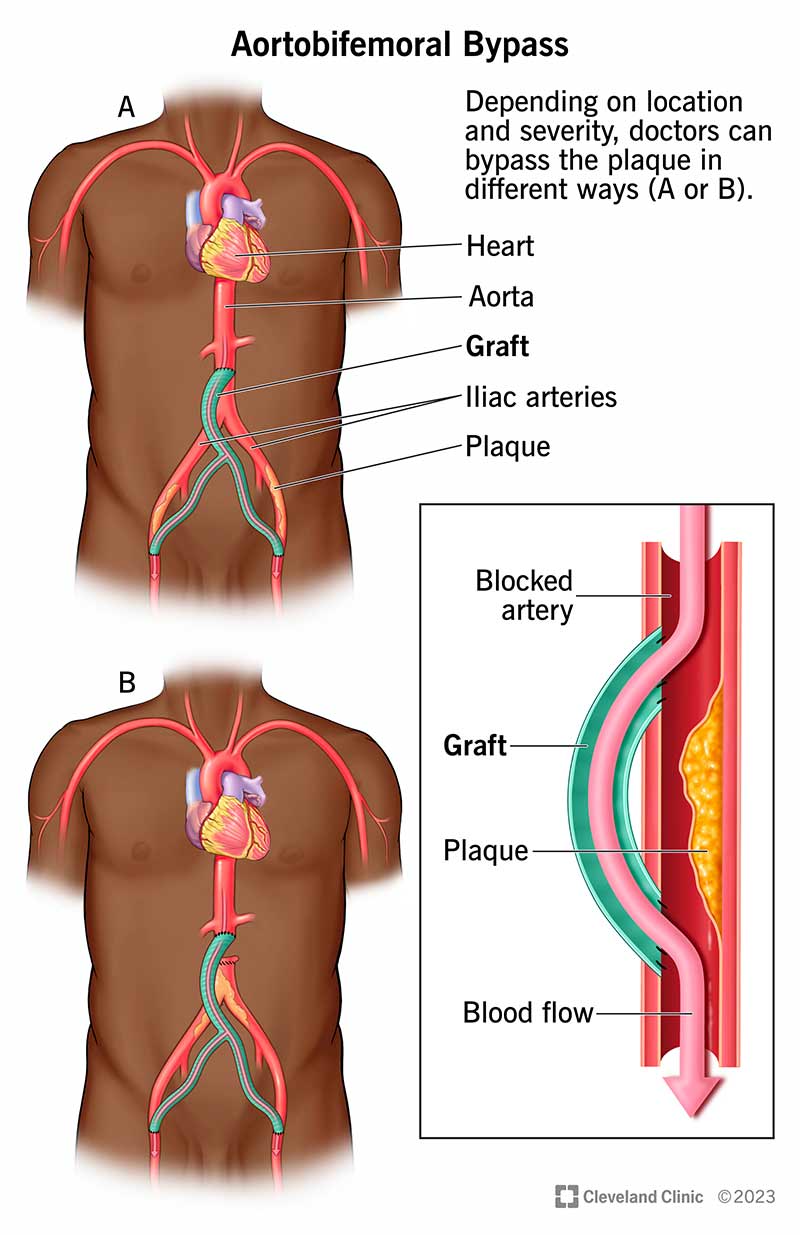Aortobifemoral bypass surgery treats severe and symptomatic aortoiliac occlusive disease (plaque buildup in major arteries in your belly). A surgeon inserts a graft, which serves as a new route for blood flow. Your blood can avoid (bypass) the clogged parts of your arteries. This surgery improves blood flow to your legs.
Advertisement
Cleveland Clinic is a non-profit academic medical center. Advertising on our site helps support our mission. We do not endorse non-Cleveland Clinic products or services. Policy
Aortobifemoral bypass is a form of vascular disease bypass surgery that surgeons perform in your abdomen (belly). It’s an open surgery that creates a new route (bypass) for blood to flow around narrowed or blocked portions of your arteries. This improves blood flow to your legs.
Advertisement
Cleveland Clinic is a non-profit academic medical center. Advertising on our site helps support our mission. We do not endorse non-Cleveland Clinic products or services. Policy
A vascular surgeon inserts an artificial blood vessel (graft) into your belly in the area of the diseased arteries. The graft typically consists of polyester. “Aortobifemoral” refers to the arteries that connect with the graft:
The graft has the shape of an upside-down letter “Y.” The top of the graft connects with the lower portion of your aorta in your belly. Each stem of the Y connects with each of your femoral arteries.
Healthcare providers may recommend this surgery if plaque buildup in major arteries in your belly or pelvis causes severe symptoms or places you at high risk for complications.

An aortobifemoral bypass graft reroutes blood flow from your abdominal aorta to your femoral arteries.
Aortobifemoral bypass surgery treats severe aortoiliac occlusive disease. With this condition, plaque gradually builds up in major arteries in your belly and pelvis. These are your:
Advertisement
Extensive plaque buildup can narrow or block blood flow in your abdominal aorta and iliac arteries. As a result, your lower body (including your legs, feet and organs in your pelvis) can’t receive enough oxygen-rich blood. Severe narrowing or blockages can lead to complications, including:
Although bypass surgery can’t cure aortoiliac occlusive disease, it can ease your symptoms by delivering blood flow to your legs. This will decrease the occurrence of the complications mentioned above.
Aortobifemoral bypass is an open surgery that requires a large incision in your belly. Healthcare providers consider this major surgery.
A minimally-invasive alternative is aortoiliac stenting with bifurcation reconstruction (AISBR). This is a form of endovascular surgery that places a stent inside your clogged arteries to open them up and improve blood flow. Some research shows that AISBR may have a lower risk of surgical complications and a shorter hospital stay than open surgery.
Your healthcare provider will determine whether open surgery or endovascular surgery is right for you. Traditionally, surgeons would use AISBR for people with a higher surgical risk. But thanks to advances in technology, surgeons today are using AISBR much more often instead of open surgery.
You may need open surgery if you’re not a candidate for endovascular surgery, or if you’ve had endovascular surgery in the past and it wasn’t successful for you. Talk to your provider about available options for you and the pros and cons of each in your specific situation.
Your surgical care team will tell you how to prepare for your surgery. In general, it’s important to:
Advertisement
You may need to visit your provider for various tests, including:
To reroute blood flow in your belly, your surgical team will perform the following steps:
You can expect the surgery to take anywhere from two to six hours.
You’ll spend four to seven days in the hospital recovering. During this time, your care team will:
Aortobifemoral bypass surgery can help ease your symptoms and lower your risk of complications from aortoiliac occlusive disease. This surgery gives you the following benefits after your recovery:
Advertisement
About 80% to 95% of surgeries successfully improve blood flow for at least five years. The success rate at 10 years ranges from 74% to 86%.
Possible complications of aortobifemoral bypass surgery include:
It’s important to discuss all possible risks with your surgical care team prior to your surgery.
Full recovery may take two to three months. But you should be able to return to some of your normal activities after about four to six weeks.
You may have incision pain for the first few weeks after your surgery. Your provider will prescribe pain medication as needed to help you feel better. Be sure to:
Advertisement
Your care team will tell you when it’s safe for you to:
In general, it’s important to take it slow in the weeks following your surgery to give your body time to recover.
Call your provider right away if you have any of these issues as you recover:
Call 911 or your local emergency number right away if you have symptoms of a heart attack or stroke.
Symptoms of a heart attack include:
Symptoms of a stroke include:
Planning for any major surgery can feel stressful and overwhelming. Your surgical team understands this, and they’ll help you feel more comfortable as you approach your surgery day. Don’t hesitate to ask any questions or share your concerns. Be sure to get all the information you need to feel ready for your surgery and prepared to take care of yourself at home as you recover.
Vascular disease may affect your life in big and small ways. Cleveland Clinic’s specialists treat the many types of vascular disease so you can focus on living.

Last reviewed on 01/30/2023.
Learn more about the Health Library and our editorial process.